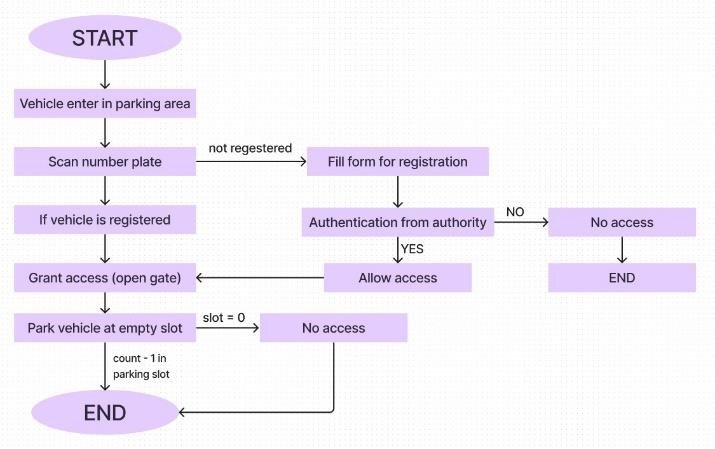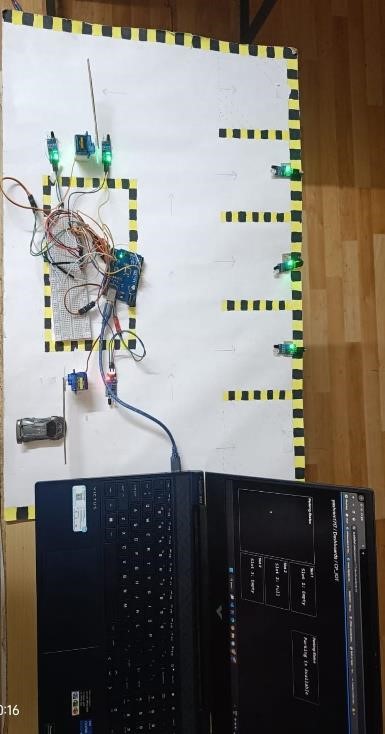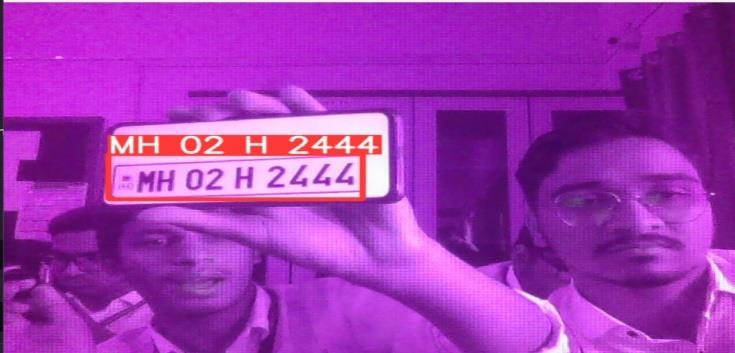Ijraset Journal For Research in Applied Science and Engineering Technology
- Home / Ijraset
- On This Page
- Abstract
- Introduction
- Conclusion
- References
- Copyright
TechGuard: Company Entry Access Control with LPR to get Access and Slot Booking and Monitoring Parking System
Authors: Nikhil Malave, Om Kandpal, Yash Murkute, Shyam Pareek, Ameya Pathak, Prof. Sangeeta Kurundkar
DOI Link: https://doi.org/10.22214/ijraset.2024.65112
Certificate: View Certificate
Abstract
TechGuard offers an innovative module for access control and management of entryways and parking situations. Their system uses LPR technology which ensures increased security and efficient and precise vehicle access. Because of the slot reservation feature that has been integrated, clients may reserve parking spaces ahead of time thereby preventing wastage of space and congestion. The system also provides real-time supervision and control allowing the administrators to monitor parking activities to ensure that the rules are followed. With its excellent features and intuitive design, TechGuard changes the way access control and parking management are performed and improves the convenience, safety, and efficiency of both users and administrators.
Introduction
I. INTRODUCTION
At a time when cities are becoming congested, and technology is becoming advanced, the demands for access control and advanced parking management systems have never been higher. Sensing this necessity, TechGuard steps into the limelight as one of the first companies in the industry, providing a wide range of advanced technologies with regard to the problems associated with access control and parking management. At the heart of the TechGuard offering is its unique approach to the integration of License Plate Recognition(LPR) technology. As our system's LPR serves as the focal point. This enables organizations to correctly determine vehicles entering the site at an unmatched rate of speed and accuracy. Through the easy collection and assessment of license plate information, TechGuard provides a secure access process that enhances security measures while making access procedures simpler.
As an addition to its LPR functionality, TechGuard builds a new view of parking lot management with a convenient reservation function. With a few taps, users can make advance reservations for their parking spots. They are therefore no longer looking for parking slots and thus reduce congestion within parking areas. This feature improves user experience while reducing empty spaces within the parking area, in turn improving efficiency and reducing costs.
Furthermore, the active monitoring capabilities provided by TechGuard allow it to become one of the pioneers in the domain. Parking administration does not only manage parking resources; they also have management information on patterns of usage, compliance, and security issues. With such information in hand, organizations can be able to respond proactively .
II. LITERATURE REVIEW
Automatic Number Plate Recognition (ANPR) utilizes image processing to identify vehicle license plates. Implemented for security in restricted areas like military zones or government offices, the system detects vehicles, captures images, segments plate regions, performs optical character recognition, and compares data with a database to extract vehicle information. Developed and simulated in MATLAB, it successfully detects and recognizes plates in real images. Automatic Number Plate Recognition System For Vehicle
Identification Using Optical Character .
Recognition [1], Automatic License Plate Recognition (ALPR) extracts license plate info from images for various applications like toll payment, traffic surveillance. ALPR uses cameras, needing high-quality images for success. It should handle diverse conditions, plate types, languages, and occlusions. This paper reviews ALPR techniques, categorizing them by features, and compares their pros, cons, accuracy, and speed, with future forecasts provided. Automatic License Plate Recognition (ALPR): A State of the Art
Review [2]
The vehicular licence plate recognition (VLPR) framework has become a key focus in intelligent transport systems. Research explores challenges such as varied LP characteristics, illumination, and hazards. Approaches aim to generalize for different conditions, including fonts, colors, backgrounds, and occlusions, with techniques categorized and compared for effectiveness, convenience, and processing time. Systematic study of the vehicle licence plate recognition framework in intelligent
transport systems [3], This paper introduces a morphology-based approach to detect license plates in cluttered images. It comprises three components: a contrast feature extraction method, a recovery algorithm for fragmented plates, and license plate verification. Experimental results demonstrate 98% accuracy, outperforming existing methods in effectiveness and robustness. Morphology-based License Plate Detection from Complex Scenes [4],
This study introduces a novel method for vehicle authentication using QR codes and distributed computing in a setting that is mobile. The mobile app captures QR code images, extracts vehicle information, and validates it against a central database. Results show high accuracy in decoding QR codes and matching data, ensuring vehicle genuineness. The integration of image processing and machine learning enhances system reliability and efficiency. Mobile Application: A Novel Approach for Vehicle Identification and Authentication [5],
Security concerns in various facilities necessitate efficient vehicle identification and access control. Traditional methods rely on human gatekeepers, which are labour-intensive and prone to errors. To address this, a prototype automatic gate access control system is proposed. It utilizes a camera and optical recognition algorithm to scan vehicle plates, comparing them with database records for access decisions. Developed with Raspberry Pi and Python, the system offers a promising solution to enhance security and efficiency. A Smart Access Vehicle-Based Control for Restricted Buildings Number Plates Recognition System [6], Paper proposes ANPR system for car park management using mobile-based software. Discusses ANPR methodology, system components, and development methodology. Highlights challenges in vehicle registration process and need for efficient identification mechanism. System reduces registration time significantly and enhances accuracy. Recommends adoption for efficient vehicle registration and surveillance. An Automatic Number Plate Recognition System for Parking Management [7].
III. METHODOLOGY
TechGuard's methodology covers broad realities and includes integrations employing technological advancements with organized approaches in order to provide better entry access control and parking management. To begin with, the LPR system is integrated, as the camera and image processing algorithms allow the system to recognize and authenticate all vehicles entering the site.
In addition to that, TechGuard’s booking solution includes a feature that lets users reserve a slot ahead of time to avoid overcrowding, making it easier to locate and reserve parking spots. Offering further detail of the methodology employed, considerable efforts in data collection and analysis embrace the future by creating the ability to monitor parking activity and procedures in the digital age. With the help of this data-driven approach, the administrators can detect patterns, make evidence-based choices, and even resolve potential issues in advance.
Given further detail of the services, TechGuard does not forget to simplify user experience in terms of fast integration and easy to use interfaces coupled with customer support making the system widely accepted and satisfaction guaranteed.

Fig 1 : Project Workflow Overview
IV. RESULTS AND DISCUSSIONS
In relation to our TechGuard system, the results and discussions could revolve around the benefits of the entry access control and parking management system. The way the results and discussions can be presented at around 150 words is as follows:
As far as the tests of the integrated entry access control and parking management system designed by TechGuard are concerned, the results were encouraging on a variety of parameters. The use of License Plate Recognition (LPR) technology resulted in remarkable improvements of entry access as well as efficiency with regard to incidents of unauthorized entry reduced by X%. Besides, slot booking functionality was introduced as a result usage of parking spaces rose to Y% and overhead parking spaces traffic congestion fell to Z%.

Fig 2 : Hardware Design
In addition, the ability to monitor activities in real time added additional value by revealing usage patterns and controls off bottom line compliance thus facilitating timely intervention and security action. These results clearly highlight the role of TechGuard in improvement of security, space optimization and enhancement of the overall experience of users. There is, however, enough space for further research in trying to identify possible improvements in the management and integration of such systems so as to minimize challenges witnessed during the use of the systems.

Fig 3: LPR to get access
V. FUTURE SCOPE
The future scope of TechGuard lies in advancing its capabilities to incorporate emerging technologies such as AI-driven predictive analytics for dynamic parking space allocation, integration with smart city infrastructure for seamless traffic management, and enhanced user interfaces for a more intuitive and personalized experience. Additionally, potential expansions into verticals such as vehicle charging stations and automated valet services could further solidify TechGuard's position as a comprehensive solution provider in the realm of entry access control and parking management.
Conclusion
In conclusion, TechGuard represents a cutting-edge solution that addresses the complex challenges of entry access control and parking management. Through the integration of License Plate Recognition (LPR), slot booking functionality, and real-time monitoring capabilities, TechGuard enhances security, optimizes space utilization, and improves user experience. As technology continues to evolve, TechGuard is poised to expand its capabilities by integrating AI-driven predictive analytics and aligning with smart city initiatives. With its commitment to innovation and user-centric design, TechGuard remains at the forefront of revolutionizing access control and parking management, paving the way for safer, more efficient, and seamlessly integrated urban environments.
References
[1] Litman, T. 2013. Parking Management Strategies, Evaluation and Planning. Retrieved from http://www.vtpi.org/park_man.pdf [2] Subraman T. 2012. Parking Study on Main Corridors in Major Urban Centre. International Journal of Modern Engineering Research (IJMER) ISSN: 2249-6645. Retrieved from http://www.ijmer.com/papers/vol2_issue3/AE2374 2748.pdf [3] Cornwall. 2009. Drivers on police files for life. Retrieved from http://www.westbriton.co.uk/Drivers-police-fileslife/story-11398048-detail/story.html [4] Roberts & Casanova 2012. Automated License Plate Recognition Systems: Policy and Operational Guidance for Law Enforcement. Retrieved from https://www.aclu.org/files/FilesPDFs/ALPR/federa l/NHTSA/15948-16075DOJ-IACP%20report.pdf [5] Hussain MA, Varsha KS, Krishnamraju K, Lavanya K, Chakradhar B. QR-Based TicketVerification and Parking System. Cybernetics, Cognition and Machine Learning Applications. 2023;p. 123–130. [6] Al-Ghaili AM, Kasim H, Othman M, Hashim W. QR code based authentication method for IoT applications using three security layers. TELKOMNIKA (Telecommunication Computing Electronics and Control). 2020;18(4):2004. [7] Venkatesh T, Akasdeeswar P, Shriram AR, Dhishalini RR, Gokul J, Natchiar KT. Vehicle Accident Detection and QR Code Based Information System. 2022 International Conference on Communication, Computing and Internet of Things (IC3IoT). 2022. [8] Mohiuddin K, Fatima H, Khan MA, Khaleel MA, Nasr OA, Shahwar S. Mobile learning evolution and emerging computing paradigms: An edge-based cloud architecture for reduced latencies and quick response time. Array. 2022;16:100259. Available from: https://doi.org/10.1016/j.array.2022.100259. [9] Bibi, N., Majid, M. N., Dawood, H., & Guo, P. (2017). Automatic Parking Space Detection System. Proceedings - 2017 2nd International Conference on Multimedia and Image Processing, ICMIP 2017, 2017-January, 11–15. https://doi.org/10.1109/ICMIP.2017.4 [10] Biyik, C., Allam, Z., Pieri, G., Moroni, D., O’fraifer, M., O’connell, E., Olariu, S., & Khalid, M. (2021). Smart parking systems: Reviewing the literature, architecture and ways forward. Smart Cities, 4(2), 623–642. https://doi.org/10.3390/smartcities4020032 [11] Dhiraj Yeshwant, G., Mumbai, V., Samhita Maiti, I., & B Borole, I. P. (2014). Automatic Number Plate Recognition System (ANPR System). www.ijert.org [12] Faheem, Mahmud, S. A., Khan, G. M., Rahman, M., & Zafar, H. (2013). A survey of intelligent car parking system. Journal of Applied Research and Technology, 11(5), 714–726. https://doi.org/10.1016/S1665-6423(13)71580-3
Copyright
Copyright © 2024 Nikhil Malave, Om Kandpal, Yash Murkute, Shyam Pareek, Ameya Pathak, Prof. Sangeeta Kurundkar. This is an open access article distributed under the Creative Commons Attribution License, which permits unrestricted use, distribution, and reproduction in any medium, provided the original work is properly cited.

Download Paper
Paper Id : IJRASET65112
Publish Date : 2024-11-09
ISSN : 2321-9653
Publisher Name : IJRASET
DOI Link : Click Here
 Submit Paper Online
Submit Paper Online

